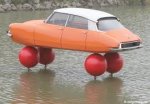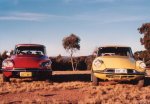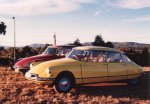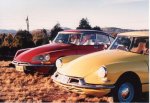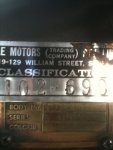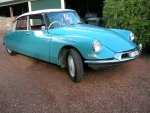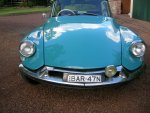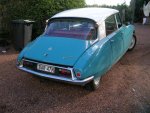Modified 1960ID
Hi Zorker,
Thanks for the feedback. I am pleased you found my comments helpful.
I have found this whole thread to be interesting.
I have owned various Citroens since 1971, in both Europe and Australia, ranging from Ami 6(1), ID19(3), GS(4), DS23 (1 auto), XM (2), Berlingo (1), and, at present, a 2009 C5 HDi Comfort and a 2008 C4 VTS Coupe – the latter two both purchased new from Continental Cars.
The original D Series was indeed a groundbreaking design, but by any rational, objective criteria, it was a very long way from being a “masterpiece”, as reference to the wealth of reference material available on the car will attest.
Because of Citroen’s precarious financial situation at the time, regardless of how good was the initial design concept, the DS that ultimately went into production in 1955 was a forced compromise in many areas – just one example being the use of the old Traction engine instead of the proposed flat six.
The DS was never subjected to a full and thorough testing and development program, which would have uncovered the many major faults found in the early years. The customers basically carried out the research and development for the company that should have been done before it was put on the market.
Major faults were prevalent in both final design and production. Failures of the hydraulics, engine overheating, noise, vibration and harshness, rapid structural corrosion due to the absence of any preventive measures, and so on, meant that the initial euphoria about the DS on the part of buyers, and potential customers, rapidly gave way to disillusionment with the car, a situation from which it took the company years to recover.
The many improvements to the D series over its production life solved most of the initial problems, and the final versions - with the exception especially of the DS23 Auto - generally redeemed the car’s reputation. However, the basic design concept of the car meant that it could never have met the new safety regulations in Europe.
Preserving D series in their “original” state is certainly a laudable endeavour, even when that “original” condition retains basic deficiencies in reliability, performance, safety, and structural integrity, that were subsequently rectified by the company itself in its later model D’s.
A good example that I mentioned in my earlier post was the ID19 original braking system, which was relaced by the later button-operated system after the endemic problems experienced with the pedal/master cylinder arrangement. The reason that this was done was to rectify a major safety and reliability issue which was found in service. Having irate Parisian taxi drivers stranded in traffic with locked brakes was hardly a situation that reflected credit on the company’s engineering prowess, or its potential marketing success.
I certainly considered it, as I had the parts, but the reason I did not convert the old braking system on my 1960 ID19 to the DSpecial system was simply that, at the time, it was not practical to do so, especially as the floor of the car would have to have been modified, as well as the hydraulic circuitry. When we thoroughly tested the braking system with the DSpecial brakes operated by the old pedal/master cylinder arrangement, there was no problem, other than the one I described in my previous post. Interestingly, in today’s world such a system, with its lack of redundancy, would never have been permitted in the first place.
So, I hope your car has the later braking system.
If I had wanted to preserve the 1960 ID19 purely as a museum piece, I would never have modified it. However, what I wanted to achieve with the modification was reliable and comfortable daily transport, with the unique characteristics of the D, and reasonable performance, incorporating developments made by Citroen themselves to improve the D series.
In the end, after a lot of work, that is exactly what I got – a much better and more enjoyable ID.
Regards,
RobL
Hi Zorker,
Thanks for the feedback. I am pleased you found my comments helpful.
I have found this whole thread to be interesting.
I have owned various Citroens since 1971, in both Europe and Australia, ranging from Ami 6(1), ID19(3), GS(4), DS23 (1 auto), XM (2), Berlingo (1), and, at present, a 2009 C5 HDi Comfort and a 2008 C4 VTS Coupe – the latter two both purchased new from Continental Cars.
The original D Series was indeed a groundbreaking design, but by any rational, objective criteria, it was a very long way from being a “masterpiece”, as reference to the wealth of reference material available on the car will attest.
Because of Citroen’s precarious financial situation at the time, regardless of how good was the initial design concept, the DS that ultimately went into production in 1955 was a forced compromise in many areas – just one example being the use of the old Traction engine instead of the proposed flat six.
The DS was never subjected to a full and thorough testing and development program, which would have uncovered the many major faults found in the early years. The customers basically carried out the research and development for the company that should have been done before it was put on the market.
Major faults were prevalent in both final design and production. Failures of the hydraulics, engine overheating, noise, vibration and harshness, rapid structural corrosion due to the absence of any preventive measures, and so on, meant that the initial euphoria about the DS on the part of buyers, and potential customers, rapidly gave way to disillusionment with the car, a situation from which it took the company years to recover.
The many improvements to the D series over its production life solved most of the initial problems, and the final versions - with the exception especially of the DS23 Auto - generally redeemed the car’s reputation. However, the basic design concept of the car meant that it could never have met the new safety regulations in Europe.
Preserving D series in their “original” state is certainly a laudable endeavour, even when that “original” condition retains basic deficiencies in reliability, performance, safety, and structural integrity, that were subsequently rectified by the company itself in its later model D’s.
A good example that I mentioned in my earlier post was the ID19 original braking system, which was relaced by the later button-operated system after the endemic problems experienced with the pedal/master cylinder arrangement. The reason that this was done was to rectify a major safety and reliability issue which was found in service. Having irate Parisian taxi drivers stranded in traffic with locked brakes was hardly a situation that reflected credit on the company’s engineering prowess, or its potential marketing success.
I certainly considered it, as I had the parts, but the reason I did not convert the old braking system on my 1960 ID19 to the DSpecial system was simply that, at the time, it was not practical to do so, especially as the floor of the car would have to have been modified, as well as the hydraulic circuitry. When we thoroughly tested the braking system with the DSpecial brakes operated by the old pedal/master cylinder arrangement, there was no problem, other than the one I described in my previous post. Interestingly, in today’s world such a system, with its lack of redundancy, would never have been permitted in the first place.
So, I hope your car has the later braking system.
If I had wanted to preserve the 1960 ID19 purely as a museum piece, I would never have modified it. However, what I wanted to achieve with the modification was reliable and comfortable daily transport, with the unique characteristics of the D, and reasonable performance, incorporating developments made by Citroen themselves to improve the D series.
In the end, after a lot of work, that is exactly what I got – a much better and more enjoyable ID.
Regards,
RobL


